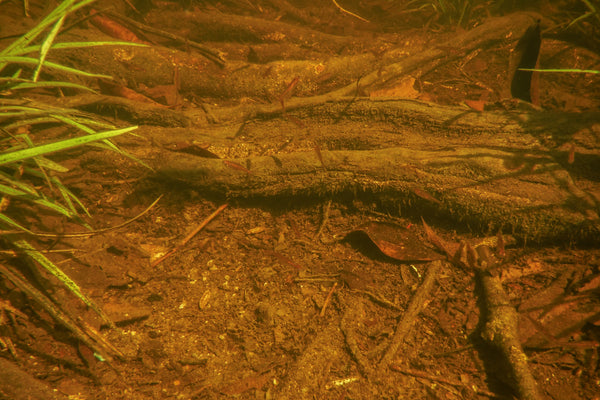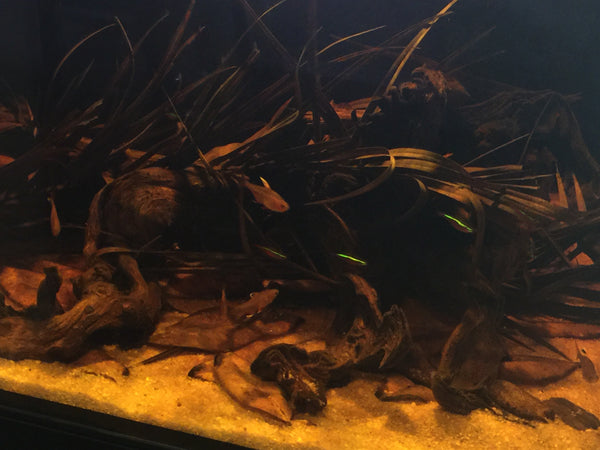- Continue Shopping
- Your Cart is Empty
Why it's okay to go slowly.
If there is one thing I have learned in a lifetime in the hobby, it's that you need to deploy massive amounts of patience for real, long-term success. Sure, you can take shortcuts, employ "hacks" or "workarounds" or whatever and speed stuff up a bit. Sometimes you can push too hard, and get from "Point A" to "Point C" without hitting "Point B"- but the results over the long term almost always are not quite as good as when you "slow your roll" a bit.

Sure, many will argue with this point.
And this isn't the first time we've talked about this stuff- and definitely will not be the last. Yet, it's so important- so fundamental to our practice-that it deserves mention yet again. When I see the questions we receive, and the questions asked on various online forums daily, which seem to question the need to understand processes and deploy patience when establishing botanical-style tanks, it's obvious that it needs to be reinforced from time to time.

Patience and allowing the space and time for our aquariums to "breathe" and "evolve", much like they do in Nature.
Yet, when we think about our aquariums and the processes which we employ to create them in this way, the parallels are striking, aren't they?
Let's examine these again, so we can illustrate this. The evolution of many aquatic habitats that we model goes something like this:
A tree falls in the (dry) forest.
Wind and gravity determine it's initial resting place (you play around with positioning your wood pieces until you get 'em where you want, and in a position that holds!).
Next, other materials, such as leaves and perhaps a few rocks become entrapped around the fallen tree or its branches (we set a few "anchor" pieces of hardscaping material into the tank).

Then, the rains come; streams overflow, and the once-dry forest floor becomes inundated (we fill the aquarium with water).
It starts to evolve. To come alive in a new way.

The action of water and rain help set the final position of the tree/branches, and wash more materials into the area influenced by the tree (we place more pieces of botanicals, rocks, leaves, etc. into place). The area settles a bit, with occasional influxes of new water from the initial rainfall (we make water chemistry tweaks as needed).
Fungi, bacteria, and insects begin to act upon the wood and botanicals which have collected in the water (kind of like what happens in our tanks, huh? Biofilms and fungal growths are beautiful...).

Gradually, the first fishes begin to follow the food and populate the area (we add our first fish selections based on our stocking plan...).

Okay, you get the idea. The stuff we do when we establish our aquariums mimics-on a surprising number of levels- the processes which occur as natural aquatic habitats evolve. It's not always a fast process.
And the thing we must deploy at all times in this process is patience.
"Radical patience!"
What's 'radical" about patience? Well, these days, it seems that we tend to celebrate "finished" more than the process to get there, which is, IMHO, kind of sad. So, apparently, patience has become a sort of radical departure from the "new normal" in then hobby. Ironically (?), the real "magic" and fascination- is the evolution of an aquarium ecosystem.

It's as much about common sense as anything, actually.
Yeah, common sense.
That is- not jumping right to "finished"...or trying to. Rather, it's about taking a bit of time- or even a long time- to allow your aquariums to "run in" and develop before pushing them along. To allow the population of the "supporting cast" of microorganisms to evolve and multiply. It's actually a surprisingly interesting time.
Just because your tank doesn't have fishes swimming around in it doesn't mean that it's not compelling or engaging. I mean, why are we always in such a hurry to get fishes in, everything set perfectly, and the tank "Instagram ready?"

I think it's because we have historically not celebrated the process of an aquarium establishing itself as a closed ecosystem.
If we make an effort to understand how aquatic systems establish themselves and function, we develop an appreciation for each and every step in the process, and how it will influence the overall "tempo" and ultimate success of the aquarium we are creating.
Suddenly, "speed" is secondary to process.
When we take the view that we are not just creating an aquatic display, but a simulation of a diverse, functioning habitat for a variety of aquatic life forms, we tend to look at it as much more of an evolving process than some sort of recipe- or a step-by-step "procedure" for getting somewhere.

Taking the time to consider, study, and savor each phase is such an amazing thing, and I'd like to think- that as students of this most compelling aquarium hobby niche, that we can appreciate the evolution as much as the "finished product" (if there ever is such a thing in the aquarium world).

It all starts with an idea...and continues with a little bit of a "waiting game..." and a belief in Nature; a trust in the natural processes which have guided our planet and its life forms for eons.
The appreciation of this process is a victory, in and of itself, isn't it? The journey- the process- is every bit as enjoyable as the destination, I should think.
In the botanical-style aquarium game, rushing stuff for the sake of "getting finished" or whatever is simply not advisable.
Here's why:
The way we have embraced the botanical-style aquarium, it's not just about achieving a certain "look." Now, yeah, we celebrate the "look" as much as anyone can. Yet, botanical-style tanks are not really a "style", they're a type of approach to creating and managing an aquarium. And what we need to celebrate is the creation- the "evolution" of a small microcosm, complete with the many life forms which encompass it.

This takes some time. Populations of these organisms can only grow and multiply as fast as the resources are available to them. Shortcuts really don't make much sense. Now sure, you can- and should- consider "jump starting" your miniature ecosystem with bacterial and microorganisms cultures, to help get these valuable organisms into the system as early as possible.

But you can't do this with the intention of "rushing" the process. It doesn't work that way.
It takes time.
The bacteria, fungi, and other organisms which serve to "process" botanicals and nutrients within our aquariums take a while to establish themselves. Much like establishing the nitrogen cycle itself, botanical-style aquariums require us to be patient while these secondary organisms arrive, grow, and multiply to sufficient populations capable of fulfilling this role within the closed ecosystem we are establishing.
The pace and duration of this process is dictated by the availability of numerous factors, including food resources, temperature, and perhaps- most important- our ability to keep our "hands off" during this time.
It's okay to go slowly.
In addition to allowing microorganism populations time to multiply the other benefit of patience when establishing a botanical-style aquarium is that it gives you time to "get in tune" with your aquarium- to observe it, understand its "baseline" operating parameters, and to make "tweaks" and "edits" to the equipment, hardscape, lighting, etc. A chance for you to get to know your new aquarium...A pretty exciting time, really.

And think about this concept which we discuss a lot around here:
As botanicals begin to break down in the aquarium, they themselves and the organisms which feed upon them become, in turn, supplemental food resources for the higher life forms- our fishes. Yeah, fish spend most of the waking hours of aquatic animals are devoted to acquiring food and reproducing, right? They need to have some food sources available to "hunt and graze" for.
That’s reality.

So why not think about this time while the tank is establishing itself as a time to help accommodate our your animals’ nutritional needs?
And in our world, that might mean allowing some breakdown of the botanicals, or time for wood or other botanicals to recruit some biofilms, fungi- even turf algae on their surfaces before adding the fishes to the aquarium.
That process- or the time frame it takes to establish. It can't be rushed.
The very process of creating a botanical-style aquarium lends itself to this "on board supplemental food production" concept. The establishment of a sort of "food web" that's pretty analogous to those found in Nature, right?

And it plays right into the work that we regularly do as botanical aquarium fans... Hardly a radical concept in our world; merely a simple "mental shift" that we can in the way we look at our typical way of establishing an aquarium.
Sure, short cuts are exciting...appealing, even- if we look at the whole goal as achieving some pre-ordained "checkpoint" in our aquarium's lifespan. However, we need to look at them for what they really are.
They are band aids, props…”hacks”, if you will.
But they are not the key to establishing a successful long-term-viable botanical-style aquarium. Ultimately, Nature, the ultimate "editor"- has to “approve” and work with any of the “boosts” we offer.
Nature dictates the pace.

We simply follow her lead.
We employ practices, such as preparation and placement of our botanicals- because they are measured steps on a long road.
We see that people come in to our little niche with some expectations of glorious finished products- achieving a certain "look", based on the tanks they see. Human nature, for sure. However, the best thing we can do for them-and their fishes- is to see that they succeed.
We love new tanks, just starting the journey, because we know how they progress if they are left to do what nature wants them to do. We understand as a community that it takes time. It takes patience. And that the evolution is the part of the experience that we can savor most of all…because it’s continuous.
Yet, in our little niche, we stress the aesthetics of the tank during the “evolution” as part of the function, too. We celebrate biofilms, brown water, and decomposition, not just for how they look- but for what they do- and what they mean to the establishment and function of our little closed ecosystems.
Tune out all of the noise and outside voices telling you to "level up" your tank. It's not a competition. It's a journey. A really, really long and enjoyable one, in which every phase is amazing. One that rushing through will never bring you the results- or satisfaction- that a deliberate, measured pace can.
And that's why it's okay to go slowly.
Stay observant. Stay studious. Stay excited. Stay engaged. Stay patient...
And Stay Wet.
Scott Fellman
Tannin Aquatics










Scott Fellman
Author